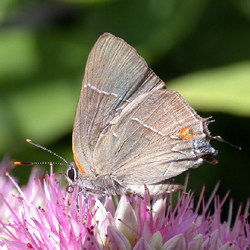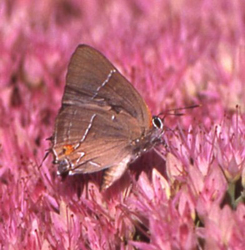Find a Butterfly
White M Hairstreak
Parrhasius m-album
Named
Boisduval and Leconte, 1833

Identification
Wingspan: 1 ‑ 1 1/2". The brilliant iridescent deep blue of both fore‑ and hindwings above distinguish this butterfly from any other New England hairstreak. Females are larger than males, with iridescence more restricted to the base of wings. The underside of the hindwing has a white spot on the leading edge, and near the "tails" an orange‑red spot adjacent to a blue‑green and black spot. A characteristic white M (or, more accurately, W) crosses the wing above the aforementioned spots. Oak Hairstreak (Satyrium favonius) shows a similar hindwing pattern below but lacks the black spot and has none of the characteristic iridescence above of the present species.
Distribution
Eastern Kansas east to southern New England; south to central and eastern Texas and east though Florida and the mid‑Atlantic states. Historic records give no mention of this species in New England. In the past two decades, however, records from Connecticut and Massachusetts suggest that this species is slowly extending its range northward.
Status in Massachusetts
Judging by recent increases in records (see below), the status of this species seems to be changing. At present it is best characterized as a rare vagrant and/or resident of the eastern and southeastern portions of the state. First reported in the state from Falmouth on Cape Cod (Barnstable Co.) by R. Edwards during the 1979 Xerces Butterfly Count (Powell & Sorenson, 1980). Subsequent records were made in New Bedford and Dartmouth (Bristol Co.) by M. Mello in 1984, 1987, and 1991, by T. French in 1988, and by D. Zimberlin in 1991. Other locations include Penikese Island (Dukes Co.), T. French in 1989 and, significant as the only record from western Massachusetts, Sheffield (Berkshire Co.), E. Dunbar in 1987. 1992 was a banner year for White M Hairstreak in Massachusetts with individual butterflies seen in Plymouth ( Plymouth Co.) on 3 June by M. Kasprzyk, in Sudbury (Middlesex Co.) on 6 August by R. Walton, and in Milford (Worcester Co.) on 21 August by R. Hildreth. L. Lovell, and B. Cassie found 5 White M Hairstreaks in northern Bristol County at Easton on 6 August. Returning two days later Cassie et al found 16 White M Hairstreaks in the same area and 4 were still present as late as 20 August. This species has been proposed for listing under the Massachusetts Endangered Species Act.

Flight Period in Massachusetts
Two flights: May/June, early July to late August. Extreme dates: 15 May and 27 and 28 August, Penikese Island (Barnstable Co.), T. French.
Larval Food Plants
Oaks.
Adult Food sources
Sweet Pepper Bush, Meadowsweet, and Narrow‑leaved Mountain Mint recorded in Massachusetts. Elsewhere milkweed, viburnum, goldenrod, and wild plum are mentioned.

Habitat
An edge species generally associated with shrubby habitats near hardwood and wetland forests. The majority of Massachusetts records are from areas in or adjacent to Red Maple and or Atlantic White Cedar swamps. Wagner (pers comm.) notes that in Connecticut, the species favors trap rock ridges and is also common along the shore.
Life Cycle
u>EGG: White. OVIPOSITION: Unrecorded. LARVA: Green with a dark dorsal stripe and seven slanted dark green side stripes. CHRYSALIS: Brown with blotching and a black dorsal ridge; said to "squeak!" (Scott, 1986). OVERWINTERING STAGE: Chrysalis.
Probably double brooded. Severe winters may kill the overwintering pupae. Eggs are deposited in May and early June, with adults emerging from mid‑July through August. A second brood likely pupates in September. It is unknown whether a partial third brood occurs this far north; however, this seems unlikely.
Notes
Initially proposed for listing by the Natural Heritage and Endangered Species Program (Harding, 1983) but abandoned because its status was unclear. The discovery of the Easton population indicates that this species should be reconsidered for listing.
Account Author
Mark Mello



